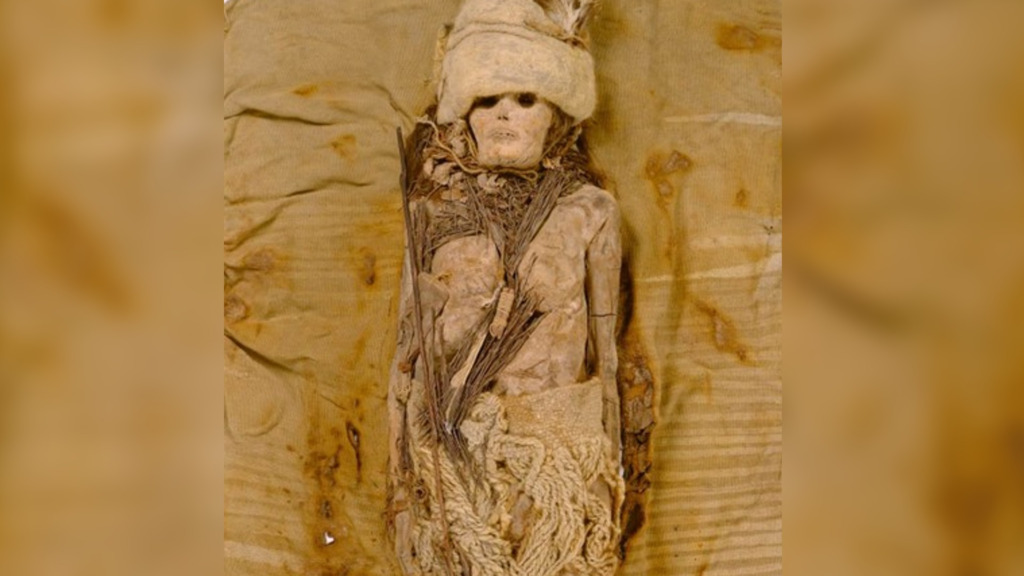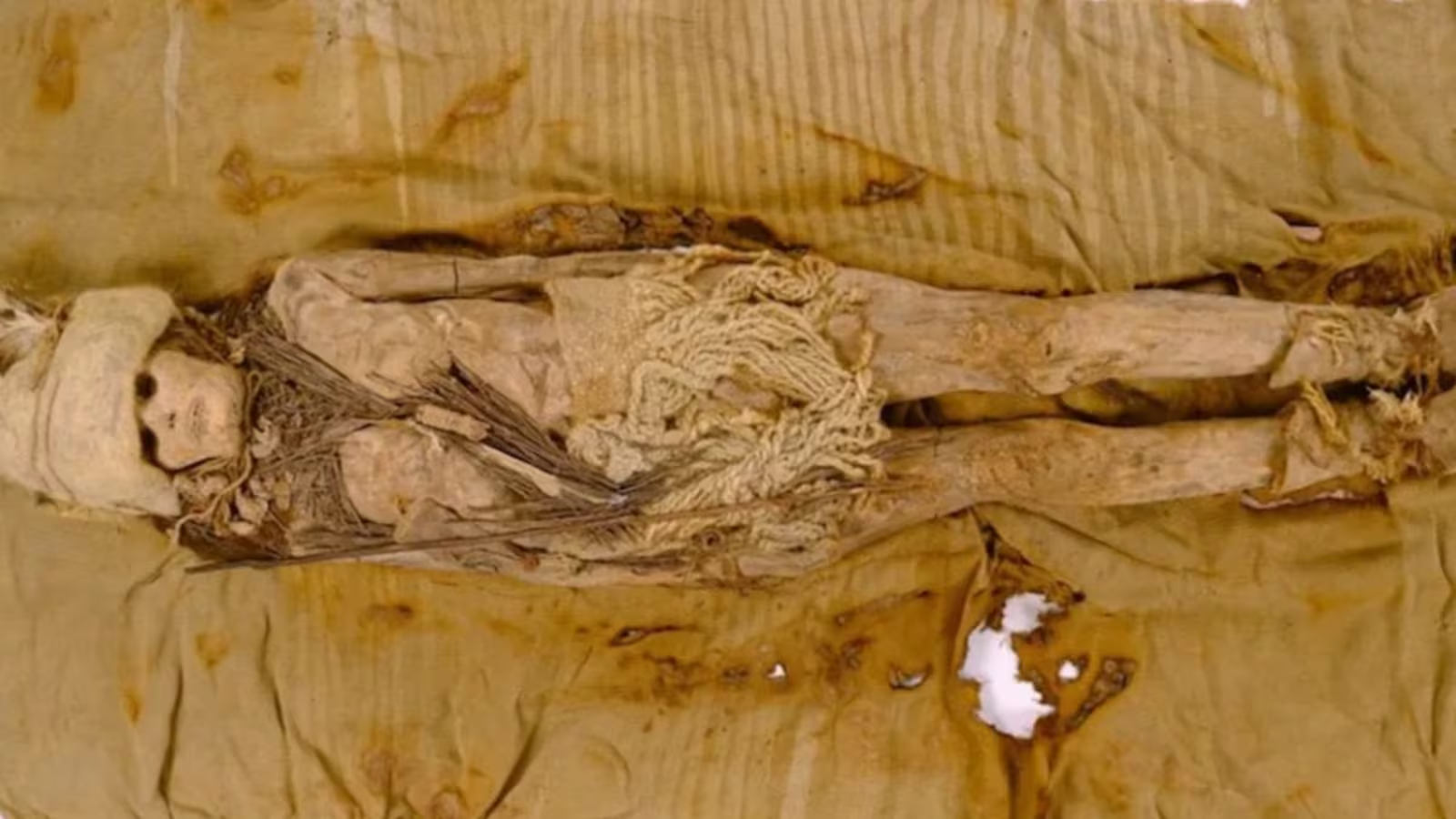The world’s oldest cheese has been discovered on 3,600-year-old mummies in Xinjiang, China, and recent DNA analysis is revealing secrets about this ancient find. The cheese, smeared on the necks of the Xiaohe mummies, is the world’s oldest cheese preserved sample of its kind ever found.
Scientists have confirmed that the ancient cheese was made from fermented cow and goat milk, marking a significant discovery in the history of dairy fermentation. This breakthrough sheds light on how fermentation techniques, such as kefir culturing, spread across Asia, unlocking clues about early dairy production methods.
Discovery of the world’s oldest Cheese
The journey to uncover the secrets of the world’s oldest cheese began more than two decades ago, when researchers first found curdled samples on mummies in China’s Xiaohe cemetery.
Read : Sewage Pipe Explosion Creates Poop Volcano in China: Watch
These samples, dating back approximately 3,600 years, sparked curiosity but were difficult to identify. It wasn’t until 2014 that another research group suggested that the curds were made from kefir, a fermented milk product.
Read : Living History: A Guide to the Oldest Cities on Earth
Recently, with the help of advanced DNA analysis, scientists have confirmed this theory and revealed that two of the cheese samples were made from cow milk, while a third was made from goat milk.
The Role of Kefir in Ancient Cheese Production
Kefir, a yogurt-like drink, is made by fermenting milk with kefir grains, which contain live bacteria and yeast cultures. When kefir is drained, it forms a lumpy mass of cheese.

The ancient samples found on the mummies likely followed this process, making them a form of kefir cheese. The discovery of this ancient cheese is significant not only because of its age but also because it offers a glimpse into early dairy fermentation practices in Asia.
Unlocking the Secrets of Asian Dairy Fermentation
One of the most fascinating aspects of this discovery is what it reveals about the spread of kefir fermentation techniques. Prior studies suggested that kefir fermentation largely spread from Russia to Europe. However, the DNA analysis of the bacteria found in these ancient cheese samples tells a different story.
By comparing the bacteria’s DNA with modern kefir samples, researchers traced a separate route of fermentation techniques from modern-day Xinjiang into Tibet and inland East Asia. This new evidence broadens our understanding of how dairy fermentation practices evolved and spread across the continent.
The Mystery of the Cheese on the Mummies’ Necks
While the discovery of the world’s oldest cheese cheese is groundbreaking, one question remains unanswered: why was the cheese smeared on the necks of the mummies? The purpose of placing cheese on the mummies is still unclear.
It could have held cultural or ritual significance, or perhaps it was a form of preservation or offering. More research is needed to fully understand the reasoning behind this unusual practice.
To unravel the mysteries of how kefir fermentation spread, scientists examined the bacteria found in the ancient cheese samples and compared it to modern kefir.

They built a bacterial family tree, tracing the lineage of these microbes over thousands of years. This analysis revealed that kefir fermentation techniques did not follow a single route. Instead, they spread through multiple regions, indicating a complex history of dairy culture development across Asia.
This discovery of the world’s oldest cheese not only provides insight into ancient dairy practices but also highlights the role of bacteria in the evolution of food production.
Because kefir can only be made using existing kefir cultures, the presence of kefir in ancient cheese offers a valuable proxy for tracing the movement of fermentation techniques. By studying the DNA of these bacteria, scientists can better understand the interactions between early civilizations and their food practices.
A New Understanding of Ancient Food Production
The discovery of this ancient cheese opens up new avenues of research into how ancient people produced and preserved food. The fact that cheese production was taking place thousands of years ago in what is now China suggests that early civilizations had already developed sophisticated methods of food preservation.
The use of kefir fermentation, in particular, indicates that these early dairy farmers had an advanced understanding of how to use bacteria to extend the shelf life of their products.
Challenges in Preserving the World’s Oldest Cheese
Despite being the world’s oldest cheese cheese ever discovered, the ancient samples did not resemble modern cheese in texture or feel. According to lead researcher Qiaomei Fu, when the cheese samples were squeezed, they felt like “dense dust.”

This is due to the thousands of years that have passed since the cheese was produced, leading to its preservation in a dry, compact form. Preserving the DNA of such ancient samples presented a unique challenge for researchers, but it ultimately provided crucial information about the history of kefir and dairy production.
As researchers continue to study ancient food remains, the discovery of the world’s oldest cheese represents a major milestone in the field.
This finding not only adds to our knowledge of ancient diets and food practices but also offers insights into the spread of food cultures across different regions. With more advanced techniques like DNA analysis, scientists are likely to uncover even more secrets hidden in ancient food samples.
The discovery of the world’s oldest cheese on 3,600-year-old mummies in China is a groundbreaking find that has revealed important information about the origins of dairy fermentation in Asia.
Through DNA analysis, scientists have confirmed that the ancient cheese was made from cow and goat milk, and kefir fermentation techniques played a significant role in its production.
This discovery not only highlights the advanced food preservation methods of ancient civilizations but also opens new doors for future research into the history of food production.

